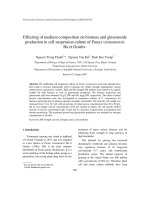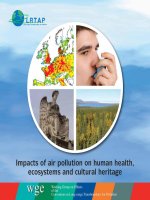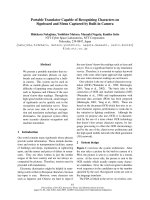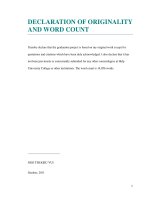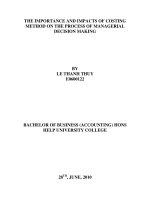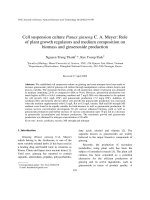Impacts of Greenhouse Gas on Feed and Livestock Production
Bạn đang xem bản rút gọn của tài liệu. Xem và tải ngay bản đầy đủ của tài liệu tại đây (1.7 MB, 24 trang )
Impacts of Greenhouse Gas on
Feed and Livestock Production
Ths. Nguyễn Thế Thao
The World Issues!!!
•
Population is estimated 9.1 billion on 2050 (UN,
2005)
•
Meat and Milk production is projected double in
2050 (229/ 580 to 456/1043 mT)
•
Livestock: 40% agirculture GDP; employs 1.3 bil
people; 1/3 humanity’s protein intake
While:
•
Land is limited
•
Average temperature have increased by 0.8
0
C
(NASA, 2005) and up to 4
O
C on 2099 (IPPC, 2007)
•
Average sea level rise: 50 mm/y (currently)
forecasted to 590 mm/y in the end of century
Source: Robert A. Rohde (2006)
available from:
“Livestock, one of top two or three most
contributors to enviromental problem”
(Steinfeld et al. 2006)
A process-based model of emissions from an animal production system.
Source: NRC (2003)
Table 1 Livestock's contribution to greenhouse gas emissions
Parameter Value Comments
Livestock’s contribution
climate change in CO
2
equivalent
18percent Includingpasture
degradation and
assuming that two-thirds
of land use change is
livestock related
Livestock’s share in
carbon dioxide
emissions
9 percent Not considering
respiration
Livestock’s share in
methane emissions
37 percent
Livestock’s share in
nitrous oxide emission
65 percent Including production of
feed crops
Source: Steinfeld et al. (2006)
Table 2 Livestock numbers (2002) and estimated carbon dioxide
emissions from respiration
Species World total
(million head)
Biomass
(mil. tonnes
liveweight)
Carbon dioxide
emissions
(million tones CO
2
)
Cattle and buffaloes
1496 501 1906
Small ruminants
1784 47.3 514
Camels
19 5.3 18
Horses
55 18.6 71
Pigs
933 92.8 590
Poultry
1
17437 33.0 61
Total
2
699 3161
1
Chicken, ducks turkey and geese;
2
Includes also rabbit
Source: Steinfeld et al. (2006)
Table 3 Global methane emissions by livestock production system
in 2004
Livestock
production
system
Emissions (million tonnes CH
4
per year by source)
Dairy
cattle
Other
cattle
Buffalo Sheep and
goat
Pigs Poultry Total
Global methane emission from manure management
Grazing 4.73 21.98 0.00 2.95 0.00 - 29.58
Mixed 10.96 27.53 9.23 6.50 0.80 - 55.02
Industrial 0.00 0.73 0.00 0.00 0.31 - 1.04
Subtotal 15.69 50.16 9.23 9.44 1.11 - 85.63
Global methane emission from manure management
Grazing 0.15 0.50 0.00 0.12 0.00 0.00 0.77
Mixed 2.93 3.89 0.34 0.23 4.58 0.31 12.27
Industrial 0.00 0.02 0.00 0.00 3.80 0.67 4.48
Subtotal 3.08 4.41 0.34 0.35 8.38 0.97 17.52
Total 18.77 54.57 9.57 9.79 9.49 0.97 103.15
Source: Steinfeld et al. (2006)
Table 4 Estimated total N
2
O emissions from animal excreta in 2004
Livestock
production
system
N
2
O emissions from manure management, after
application/deposition on soil and direct emissions
(million tonnes CH
4
per year)
Dairy
cattle
Other
cattle
Buffalo Sheep
and goat
Pigs Poultry Total
Grazing 0.11 0.54 0.00 0.25 0.00 0.00 0.90
Mixed 0.30 1.02 0.17 0.43 0.33 0.27 2.52
Industrial 0.00 0.08 0.00 0.00 0.11 0.09 0.27
Total 0.41 1.64 0.17 0.68 0.44 0.36 3.69
Source: Steinfeld et al. (2006)
Table 5. Estimated of methane emission from animals
(millon tonnes)
Species
1984
(Crutsen et al. 1986)
2004
(Steinfeld et al. 2006)
Cattle 54.6 73.54
Buffalo 6.2 9.57
Sheep and goat 8.3 9.79
Pig 0.9 9.49
Poultry - 0.97

